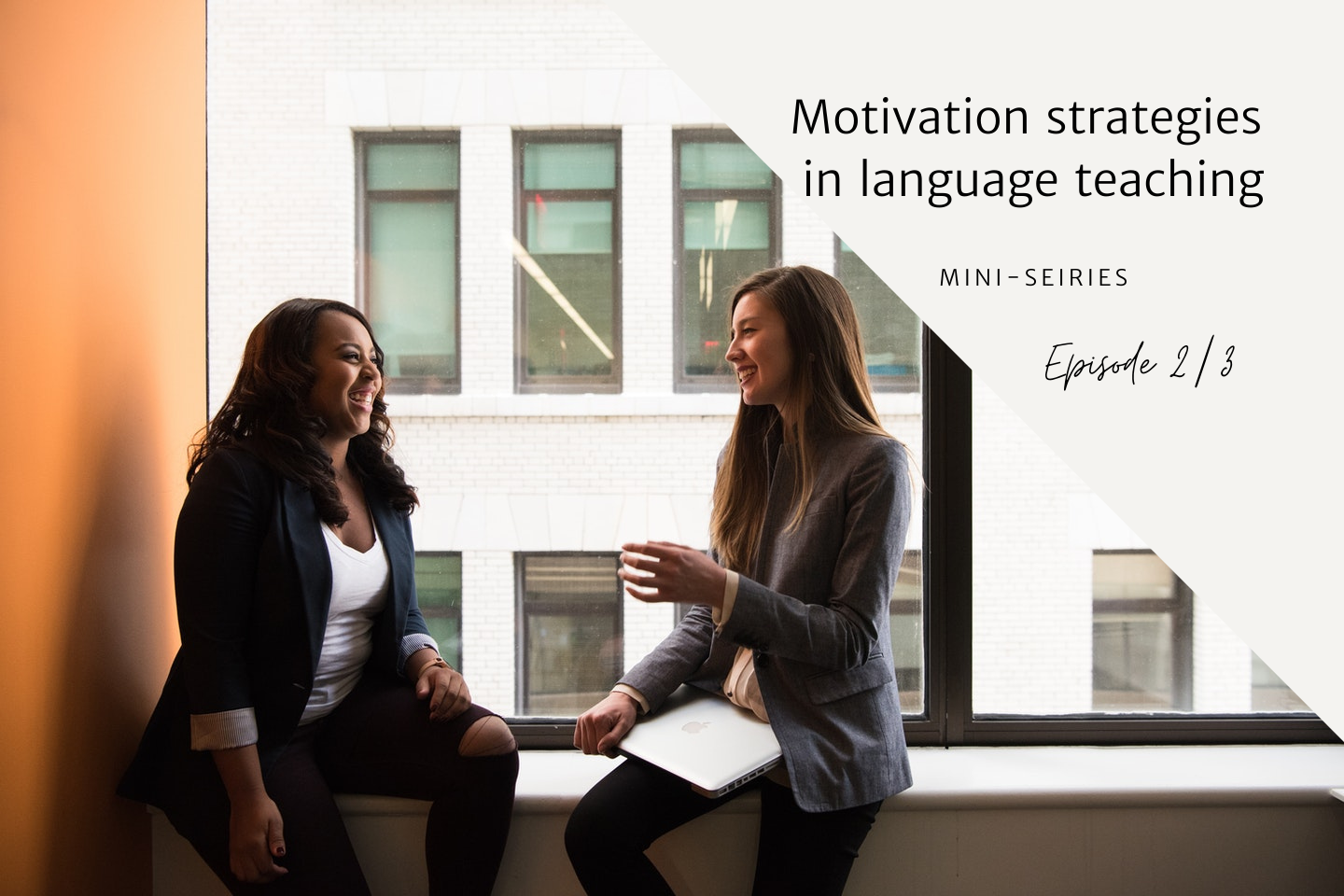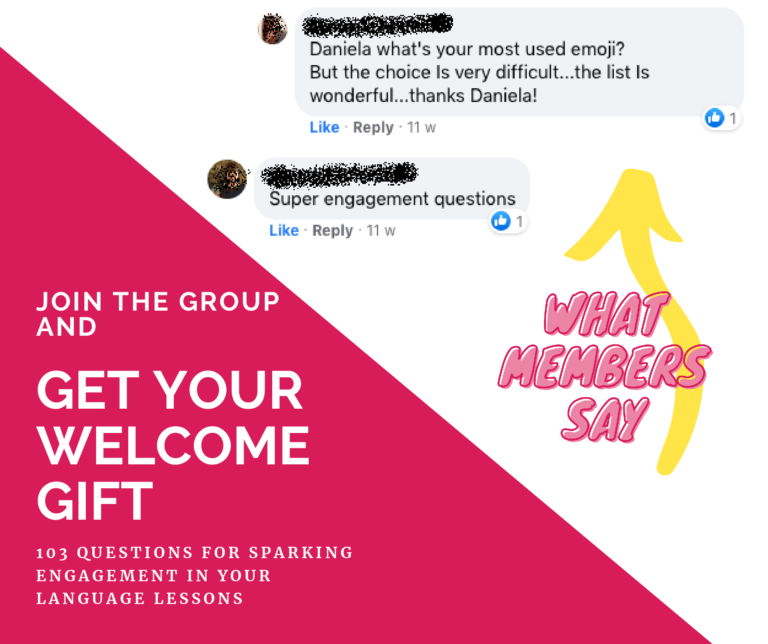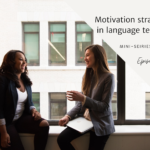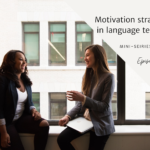
Implementing the right strategies to engage students in the classroom the most challenging issue language all teachers face. The good news is there is actually a framework of strategies that language teachers can implement right away in order to produce enjoyable, long-lasting learning experiences.
As promised in the previous post [link to post], in this second episode dedicated to motivation in language learning I’m going to give you a list of activities, tips and instructions you can implement straightaway in the classroom.
In the first episode of this mini-series you learnt about the difference between controlled motivation and autonomous motivation, from the perspective of Self-Determination Theory:
- When students’ behaviour depends on controlled motivation, they learn because they want to get a reward, or to comply with a requirement (e.g. an academic requirement or a job requirement), or to avoid a punishment, or to meet someone else’s expectations. In other words, external variables affect students’ behaviour and their overall approach to learning the target language.
- When students’ behaviour depends on autonomous motivation, they learn because learning the target language is relevant in order for them to achieve something important to them, for instance a personal life goal. Motivation, in this case, comes from the inner awareness and it matches with the students’ personal identity and values.
Have you already downloaded the FREE cheat-sheet about the strategies to engage students in the classroom? You can get it below:
Intrinsic motivation is the target for optimal classroom learning. (Muñoz-Restrepo, Ramirez, & Gaviria)
Acquisition and meaningful learning are tightly connected with autonomous motivation. In fact, language teachers’ ultimate target should be boosting the so called intrinsic motivation, which is the highest expression of autonomous motivation.
In episode #1 of this mini-series you learnt that, according to SDT, in order to feed autonomous motivation and to take the students to intrinsic motivation, language teachers need to fulfil 3 basic, psychological needs:
- Autonomy
- Competence
- Relatedness
These 3 basic needs work as motivational triggers. When teachers satisfy the 3 psychological needs, then intrinsic motivation takes place and triggers meaningful learning and long-lasting acquisition.
What is autonomy?
Students experience autonomy when they are able to make their own choices and decisions about their learning process. For example, when they plan and schedule the time they want to dedicate to their studies, or when they are willing to do extra homework and take further actions beyond the tasks given by their teachers.
What is competence?
Students experience competence when they feel confident they can perform effectively. For instance, students feel competent when they know they can meet an academic challenge (e.g. a test), or when they see they can easily catch up with the content covered during the lessons.
What is relatedness?
Relatedness means belonginess. Students experience relatedness when they feel connected with other people involved in their learning process. For instance, according to the authors Ryan and Deci, students who feel that their teachers genuinely listen, value, and respect them are more likely to identify with their teachers’ values and practices.
So, when we, language teachers, design and deliver in order to meet those basic needs, then we become able to facilitate autonomous motivation which leads to intrinsic motivation. Fulfilling the 3 needs produces enjoyment for learning.
The facilitation from controlled to autonomous/intrinsic motivation is a long-term process, rather than a one off epiphany:
It is rare to find dramatic motivational events that—like a lighting or a revelation—reshape the students’ mindsets from one moment to another. Rather it is typically a series of nuances that might eventually culminate in a long-lasting effect. (Z. Dörnyei)
As a consequence, language teachers’ approach to teaching should focus on intrinsic motivation in the day-to-day practice. Then, is there a way we can implement that facilitation?
Yes, there is a way! We need to implement specific strategies to engage students in the classroom. Language teachers can put into use a series of strategies aiming at bringing the students to intrinsic motivation. Zoltán Dörneyi is author of the most exhaustive collection of motivational strategies in language teaching. For this post I’ve selected a small part of the strategies he presents in his work, according to what I believe it is easier to take the first step with. Also, a big list of strategies might overwhelm you, and this is something I rather prefer to avoid!
In this episode #2 I’m going to give you the main, probably the most effective, strategies for boosting autonomy and competence. I’m going to complete the picture with the strategies for relatedness in the next episode #3.
Strategies to engage students in the classroom through autonomy
As Dörnyei himself said, sometimes the best motivational practices are those that have to do with improving the clarity and quality of instruction. The following strategies goal is to make sure the students are clear on the tasks they are asked to accomplish, as well as they are clear on the benefit of accomplishing those tasks.
- When you present a task | It’s important to explain the purpose and benefit of tasks. This means providing explanatory rationales. A rationale is a “verbal explanation of why putting forth effort during a learning activity might be a useful thing to do”. When presenting a task:
- Explain where the activity fits in within a sequence or bigger picture, and how it relates to the overall goals of the class.
- Try and make a connection between the task and the students’ personal daily life and point out how the skills learnt will be useful in enabling them to achieve real-life agendas.
Autonomy means also freedom, meaning the freedom students experience when they are able to organise their studies and have an active role in the activities:
- Support choice and decision making | Giving choices in the classroom doesn’t mean to give the students the chance to do nothing. On the contrary, it means to offer options that are connected to the students’ needs, interests, preferences, goals, and desires. Ways to support choice and decision making:
- let students choose the format in which to present ideas
- let students make decisions regarding how they want to tackle learning tasks (method, self-pace) or who they want to group with (in pairs, individually, small group).
Strategies to engage students in the classroom through competence
Keeping the tasks in the classroom easy and clear to carry out helps to keep the students focused on the goals. Confusion definitely ruins motivation. That’s why it is so important to provide the students with thorough, easy-to-understand and step-by-step instructions. It makes the students feel supported and able to accomplish a task. I’m going to give you 2 main strategies you can test out:
- Providing and contributing clues. Rather than giving explanations and solutions to the students’ questions, try to help the students to develop the thinking skills and problem solving approach that enable them to find the answers by themselves. Try to provide them with clues and suggestions, rather than correcting the mistakes straightaway. For instance, ask them to correct a mistake by themselves once you have let them know there is a mistake to fix.
- Providing Descriptive Feedback. Feedback should be specific to each student’s performance and not standardized. It is descriptive, it is based on regular observations of student behavior and not on explanations or judgements related to the students’ performance. It should not be overwhelming. Feedback should be given soon after the assessment.
In another post of this blog you can find more about giving feedback and also a free guide for you to download so that you can take action right away!
How can language teachers implement strategies to engage students in the classroom?
In episode #1 I explained a 3-step strategy for triggering autonomous motivation:
- Identify your students’ motivational regulators. Simply ask them: “Why do you study French?”, “Why did you choose to study English?”. According to what they say, you should be able to relate their answers to either controlled or autonomous type-of motivation.
- Give them what they want and connect. You’ll need to connect with their needs and motivational regulator (trigger) in first place, meaning you’ll give them what keeps them motivated at that specific moment. If their motivational regulator is controlled, for instance, reward their efforts with stickers, prizes, other types of rewarding. If they are learning because they want to feel accepted by others or to make someone else proud of them, then make them feel safe in the relationship with you or with those people. After all, they are manifesting a need for deeper connection with these people. If you try to skip this step and jump to point #3 (see below), they might perceive their needs are not fulfilled. I invite you to download the cheat sheet “Feeding motivation in language learning” to get a complete picture of: the types of motivation, where the behaviours come from and why the behaviour is done, examples, how to feed the different types of motivation (what the students want and how to fulfil those needs). What about the students who seem to be totally demotivated? How can we trigger some kind of motivation? You’ll find answer in the cheat sheet.
- Take them where you want to take them. Start from giving them what they want (see above), but then lead them where you want to take them. Bear in mind you want to address all their efforts in order to trigger intrinsic motivation. That’s the end game. How can you do that? This post collected some of the most effective strategies for boosting autonomy and competence.
Conclusions:
Teachers should facilitate autonomous motivation to help the students to transform controlled behaviours into autonomous behaviours and eventually to take them to develop intrinsic motivation.
In fact, intrinsic motivation triggers meaningful learning and helps the students to become fully self-efficient in learning a language as well as to really enjoy language learning.
On the contrary, controlled motivation is weaker and contingent: it lasts for the time the reward is taken or the test is passed. Controlled motivation alone doesn’t bring to enjoyable, fulfilling learning experiences.
In order to facilitate autonomous motivation, teachers should fulfil 3 psychological needs: autonomy, competence and relatedness. This post showed the strategies for boosting autonomy and competence. The strategies to engage
Next steps:
Stick to the 3-step strategy explained above and download the cheat sheet “Feeding motivation in language learning”. I suggest to start from there. Also, my advice is to play around with the strategies for autonomy and competence. Choose one strategy you will focus on at a time and give it a try, one strategy for each lesson.
In the next episode:
In the next and final post of this mini-series you’re going to learn about the strategies for boosting relatedness, according to Dörnyei and also from suggestopedia perspective.
In the next post I’m going to answer the following questions:
- How can we create and feed a sense of belonginess in our students?
- How can we build and solidify a trustful relationship with our students?
Catch up in episode #3!
Want more support?
Join the Facebook group Independent Language Teachers Collective to get daily advice, tons of free training and to branch out with other independent language teachers like you!
ALSO…
Available only for the Collective members: free list 103 question for sparking engagement in your language lessons.
This is what members say about the freebie:

Join in the Collective and grab your welcome gift:
Join Facebook Group


